
Advertisement
Quick Links
Enter the Faux Spring Reverb, a pedal designed with exactly one goal in mind: emulate the sound of a classic spring reverb head, as
true as can be done without having a giant spring tank with tubes feeding its input (and all the noise and issues that come along
for THAT ride). It may sound like a modest goal, but every e ort has been made to keep the dry signal pure, the wet signal authen-
tic, and the overall result simple, easy to adjust, and beautiful to play and hear.
To get the most out of your new pedal, you'll want to become very familiar with the controls. The Faux Spring Reverb features an
accessible control setup, with three straightforward knobs that work together to allow you to dial in precisely your sort of reverb
tone: Level, Tone, and Depth. The Faux Spring Reverb features an all-analog dry signal path, so your base signal remains completely
una ected. As with all Wampler Pedals products, the Faux Spring Reverb includes high-quality true-bypass switching which takes it
completely out of the signal path when bypassed. Experiment and enjoy!
Bypass Switch – A true-bypass footswitch ensures solid, mechanical removal of the circuit when it isn't wanted, meaning you don't
lose any tone when the pedal is o .
Level – This control adjusts the amount of wet signal present. Sometimes you want a subtle, gentle undertone of reverb; some-
times you want a brash, wet, springy goodness. The pedal works best going into your amp, and it is very important to consider that
as you raise the gain on your amp, especially if it begins to overdrive/distort, the sound of the reverb will raise dramatically because
of the natural compression introduced by amp drive. To keep the amount of reverb where you want it, make sure you adjust the
Level control carefully when you're at your desired amp volume. Using pedals in front of the Faux Spring Reverb does not require
this adjustment, because they are playing into the simulated spring reverb sound. It's only if the Faux Spring Reverb's signal goes
into something that creates overdrive or distortion that you need to be careful in adjusting the Level control to ensure that you
don't get more reverb than you intended. This knob, used in conjunction with the Tone and Depth knobs, also allows you to dial in
a really interesting undertone to the general sound, which you can play over for a lot of texture. I'll make sure to include a preset
that demonstrates that usage.
The Faux Spring Reverb o ers a sound from a time when amps were rst starting to
add features that guitarists would want, a time when, for example, Fender® released
their dedicated spring reverb head in 1963, but had the bright idea to stick that mojo
in an amp and see how it works!
Of course, we know now that it works really, really well, but there's a tone to the
classic designs that's hard to come by in many amps these days, especially if your amp
is one of the modern "retro-style" amps with a pristine signal path and none of the
extras larger companies have picked up along the way, on purpose! What's happened
in the meantime? So many di erent varieties of digital simulations of reverb have
come and gone (with a few sticking around as studio favorites, commanding high
prices), o ering sounds that are supposed to emulate an amp in a hallway, or an amp
in a concert room, or an amp in a closet, or a plate reverb, or a reverse plate reverb, or
any combination of the above, hey, why not throw the kitchen sink at it?
Why not give you so many possible options that you don't pay too much attention to
how any one option sounds? If you've got quantity, what else do you need, right? We
don't think so.
Studio units might be exible, but most of the time, they're not o ering you the
sound.
Many guitarists intuitively appreciate the sensitive, touch-responsive, beautifully
detailed nature of spring reverbs. Many guitarists, however, don't have access to that
classic sound, either because their amp doesn't feature reverb, or it has reverb with a
not-so-great imitation of prior designs.
Advertisement

Subscribe to Our Youtube Channel
Summary of Contents for Wampler Faux Spring Reverb
- Page 1 Enter the Faux Spring Reverb, a pedal designed with exactly one goal in mind: emulate the sound of a classic spring reverb head, as true as can be done without having a giant spring tank with tubes feeding its input (and all the noise and issues that come along for THAT ride).
- Page 2 – see their individual return policies for speci c information. All Wampler Pedals, Inc. pedals carry a 5-year, fully transferable warranty that covers defects due to parts and labor. The warranty begins at the point of purchase.
















Need help?
Do you have a question about the Faux Spring Reverb and is the answer not in the manual?
Questions and answers